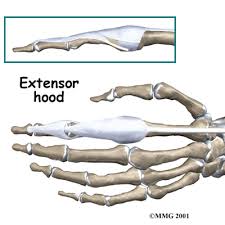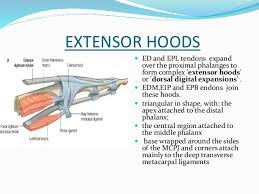Extensor Hood Mechanism Hand
This article or area is currently under construction and may only be partially complete. Please come back soon to see the finished work! (17/03/2020)
Original Editor - Your name will be added here if you created the original content for this page.
Top Contributors - Lucinda hampton, Uchechukwu Chukwuemeka, Kim Jackson, Shaimaa Eldib and Manisha Shrestha
Introduction[edit | edit source]
The extensor hoods are triangular aponeuroses by which the extensor tendons insert onto the phalanges.
Anatomy[edit | edit source]
Extensor Mechanism, also known as the extensor expansion is an elaboration of the extensor digitorum comunis (EDC) tendon on the dorsum of each phalanx.
The extensor indicis (EI) and the extensor digiti minimi (EDM) insert into the extensor mechanisms of the second and fifth digits, respectively.
Several tendinous structures comprise the extensor mechanism:
- 1.The EDC tendon attaches by a tendinous slip to the proximal phalanx, through which it extends the MP joint.
- 2. The central tendon (or "slip") proceeds dorsally to attach to base of middle phalanx, where tension can extend the PIP joint.
- 3.The lateral bands proceed on either side of dorsal midline and rejoin before attaching to the distal phalanx. Tension in the lateral bands extends the DIP joint.
- 4. The extensor hood surrounds the MP joint laterally, medially, and dorsally, and receives tendinous fibers from the lumbricales and interossei.
- 5. Fibers of the oblique retinacular ligament (ORL) attach at the sides of the proximal phalanx and digital tendon sheaths, and proceed to distal portion of lateral bands. Thus, the ORL's line of application is volar to the PIP joint's lateral axis and dorsal to the DIP joint's lateral axis.
- 6. Oblique retinacular ligament
PIP extension (produced by other tissues in the extensor mechanism) elongates the ORL, creating passive tension that extends the DIP. The DIP extension helps open the hand.
DIP flexion (produced by the FDP) elongates the ORL, creating passive tension that flexes the PIP. The PIP flexion assists in finger closure.[1]
Sub Heading 3[edit | edit source]
Resources[edit | edit source]
- bulleted list
- x
or
- numbered list
- x
References[edit | edit source]
- ↑ Biomechanics of the hand Gwenda Sharp OTR and Dave Thompson PT Available from:https://ouhsc.edu/bserdac/dthompso/web/namics/hand.htm (last accessed 17.3.2020)








